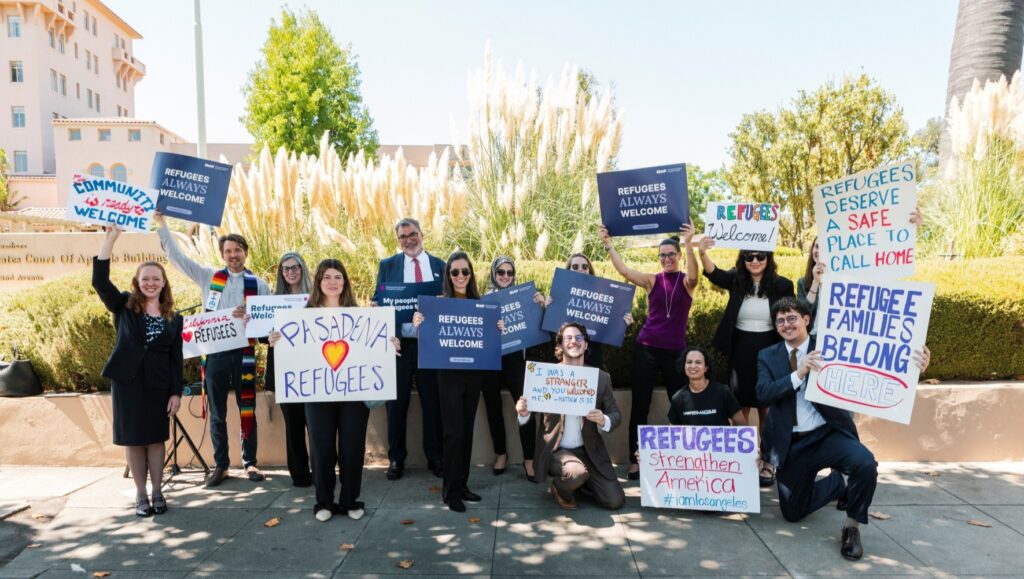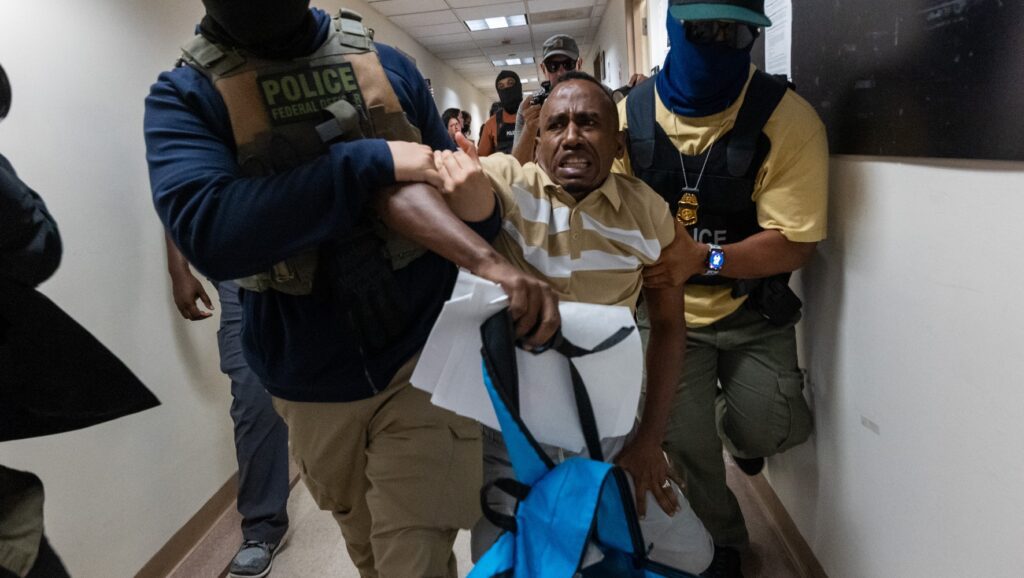
On Wednesday, April 13, a bus carrying nearly 30 asylum seekers and migrants from Colombia, Cuba, Venezuela, and Nicaragua arrived in Washington, D.C., just blocks from the U.S. Capitol. The passengers had traveled 1,700 miles from Del Rio, Texas, in a trip chartered by Texas Governor Greg Abbott.
The bus was the first to arrive following Abbott’s April 6 announcement that Texas would begin sending migrants to the nation’s capital. The governor’s announcement was designed as a response to the Biden administration’s decision to end Title 42, a public health order that essentially closes the U.S.-Mexico border to asylum seekers.
Five months later, Title 42 is still in place at the border due to an injunction issued by a federal judge in Louisiana. But efforts to send migrants from border towns in Texas and Arizona to “sanctuary cities” further north have only increased. In the ensuing months, they have expanded to include New York City, Chicago, and Martha’s Vineyard, Massachusetts.
HIAS has been involved in a direct local response in Washington, D.C. — less than 10 miles from HIAS’ Silver Spring headquarters — and on the local and national advocacy front. As Melanie Nezer, HIAS’ Senior Vice President of Global Public Affairs, said in a recent statement: “HIAS is engaged in this effort because these buses are dropping off migrants and asylum seekers in our own backyard, and we have the experience and capacity to help.”
To explain the situation in greater depth and what HIAS is doing to help, three members of HIAS staff directly involved in the response — Naomi Steinberg, vice president of U.S. policy & advocacy; Chelsey Berlin, director of community engagement programs & initiatives; and Patrick Culver, emergency operations manager — came together to answer some frequently asked questions.
Walk us through the situation. What’s been happening so far?
Since April 2022, Texas Governor Greg Abbott has provided funding to bus migrants and asylum seekers from Texas to Washington, D.C. In May, Arizona Governor Doug Ducey joined the effort. Since the first arrivals, more than 9,400 people have arrived in D.C.
During the late summer, Texas and Arizona also started to send buses to New York City and Chicago. In mid-September, Florida Governor Ron DeSantis sent two planes of asylum seekers, mostly Venezuelans, to Martha’s Vineyard, even though the people on the flights had reportedly originally arrived in Texas.
Many of the people on the buses started their journeys in Venezuela, and at present the majority of the buses are going to New York and Chicago — although that could change, too. There is a real ebb and flow to all of this. We anticipate that buses will continue to arrive in these cities and in Washington, D.C., as well as expand to other parts of the country.
Why are the governors of Texas, Arizona, and Florida doing this? And why now?
The governors of these states have made clear that they want to make the following point: Their states are overburdened by large numbers of asylum seekers and migrants, and other states should help to address this issue. It’s safe to assume that the timing — months before the midterm elections — is not a coincidence.
While there are real challenges with our asylum system, including at the border, these busing trips are not a solution.
Most people who arrive at the U.S.-Mexico border do not stay in border communities. They move on to other cities and states where they have family and friends. The narrative that border towns are permanently housing thousands and thousands of migrants is erroneous.
Helping to move people away from the border is not an inherently bad idea. It’s about how it is done. When done correctly, there should be coordination between sending and receiving communities, and everyone boarding the buses should be making fully informed, consensual decisions about where they are going. When the migrants arrive in their chosen destination cities, they should have access to an efficient, expeditious work permit process; safe, affordable housing and shelter opportunities; case management services; and access to legal counsel.
What are the immediate and long-term needs of those arriving in Washington D.C.?
There is a continuing need for space to provide immediate, mid-term, and long-term shelter. Many people get off the bus with very little and need food, clothing, shoes, a cell phone, and other essential items. Some have health concerns, some women are pregnant, and they do not have a clear way to access services. Much of the arriving population has been on a journey lasting many months. This bus is only one component of a journey, often fraught with significant trauma along the way for many of them.
Until recently, most arriving asylum seekers moved on to other cities. However, as of the past 6 weeks, the majority of the arriving population has chosen to stay in the Washington, D.C. area. Kids need to go to school, people need access to case management services, and there needs to be a way for them to properly integrate into their new communities.
What are some of the logistical challenges for organizations trying to respond to these needs?
Our experience has been that information is in short supply — organizations are able to respond more effectively if they know what to expect. The responding organizations are made up of professionals and volunteers who are doing their best to provide services despite receiving little information about the arriving buses. There are also many volunteers who are not affiliated with organizations and do not have any professional training in this area but are nonetheless stepping up to offer welcome and support.
On some recent days, the drop-off point in Washington, D.C. has changed without notice to responding organizations or to the city. Organizations have been ready to respond but needed to make adjustments at the last minute after the buses have already arrived. Buses that arrive from Texas do not coordinate with organizations about who is on the bus or what needs they have. Organizations must be ready for anything when the buses show up, and this is a significant challenge.
What would you say to those who call this a response to illegal immigration?
The individuals and families who are arriving on buses from Texas and Arizona, and on the planes to Massachusetts, are here legally. They approached a port of entry at the border and were granted permission to enter the U.S. Many of them will now start the process of seeking asylum here. It is legal under U.S. law to seek asylum, regardless of the location or method of entry to the United States.
If we want to have a debate about how to respond to specific border policies and/or our asylum system writ large, that’s a debate worth having. But it has to be based on facts.
Yes, there are a lot of people coming to the U.S.-Mexico border, even with restrictive policies like Title 42 still in place. Yes, our immigration courts and asylum process are backed up, forcing people to wait on average five years for their cases to be adjudicated. Yes, asylum seekers, although here legally, do not have access to case management services (like refugees who come through the USRAP do). Yes, asylum seekers do not have automatic access to legal counsel.
These issues have appropriate policy responses — but the claim that moving people from the border is a response to illegal immigration is simply not the case. This approach does nothing whatsoever to stem the tide of people arriving at the border or meaningfully reduce immediate pressures on border communities.
What is HIAS doing to support the response, and how can people help?
HIAS is helping to lead the coordination of local and national advocacy groups’ response to this situation. Our primary advocacy priorities are ensuring that people arriving have immediate safe, short-term shelter and access to safe medium-term housing options; FEMA’s emergency food and shelter program receives increased funding and flexibility; asylum seekers are able to quickly get their work permits and find employment; and case management systems are in place so that asylum seekers have access to the support they need.
Together with our partners, HIAS identified a gap with information flows, not only in the D.C. response, but among multiple receiving cities. To help address this gap, we are increasing our staff capacity by bringing on an emergency response specialist. In doing so, we will help to streamline coordination between advocates and responders in the different cities where buses are arriving.
HIAS staff on our Community Engagement and Social Services teams are organizing our existing volunteers in the Greater Washington, D.C. area to provide financial and material contributions as well as in-person volunteer support to those spearheading the direct response to buses arriving from the southern border. We have had a tremendous response from our local volunteer network, including an outpouring of donated gift cards and supplies for dignity kits. Volunteers met recently to assemble roughly 350 dignity kits that will be distributed to those arriving in the D.C. area. In tandem, HIAS staff are connecting with responding groups in other cities, such as New York and Chicago, to better understand the needs of migrants arriving to those areas and how local HIAS supporters may be able to help in ongoing efforts.
To support HIAS’ efforts to respond to buses arriving from the U.S.-Mexico border, please visit hias.org/donate.


